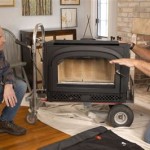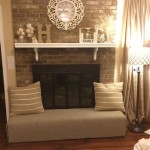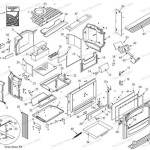Mounting a Flat Screen Over a Brick Fireplace: A Comprehensive Guide
Mounting a flat screen television above a brick fireplace can enhance the aesthetic appeal of a living space, creating a visually engaging focal point. However, this mounting project presents unique challenges compared to standard wall installations. Brick is a hard, brittle material, requiring specialized tools and techniques to ensure a secure and stable installation. Careful planning and execution are critical to prevent damage to the brickwork, the television, and potentially, the structural integrity of the fireplace itself. This article provides a comprehensive guide to safely and effectively mounting a flat screen television over a brick fireplace, addressing key considerations and practical steps necessary for a successful outcome.
Assessing the Feasibility and Planning the Installation
Before commencing any physical work, a thorough assessment of the fireplace and surrounding area is essential. This initial phase involves several key steps. First, the structural integrity of the fireplace must be evaluated. Look for cracks, loose bricks, or signs of deterioration. If any compromise to the structure is detected, consult a qualified mason or structural engineer before proceeding. Mounting a heavy television on a weakened fireplace could lead to catastrophic failure.
Next, consider the type of fireplace. Is it a functioning wood-burning fireplace, a gas fireplace, or a purely decorative element? If the fireplace is a working wood-burning model, the heat generated can damage the television's internal components over time. Even gas fireplaces can produce significant heat. In these cases, a heat shield or a recessed alcove may be necessary to deflect or dissipate the heat away from the television. The manufacturer's specifications for the television should be consulted to determine the maximum operating temperature and recommended clearance from heat sources.
The viewing height should also be carefully considered. Mounting the television too high can lead to neck strain and an uncomfortable viewing experience. Ideally, the center of the screen should be at or slightly below eye level when seated. Measure the distance from the floor to the average eye level of viewers in the room, and calculate the appropriate mounting height accordingly. Bear in mind the height of the mantel, if present, as this will dictate the lowest possible mounting point.
Finally, assess the availability of power and signal connections. An electrical outlet and cable or antenna connections will be needed to power the television and receive programming. Running these cables behind the wall provides a cleaner, more aesthetically pleasing installation. However, brick walls can make cable routing challenging. Consider the ease with which cables can be run through the hearth, up the wall, or around the fireplace. If concealing cables is impractical, wire management solutions such as paintable cable channels can be used to minimize their visibility.
Selecting the Appropriate Mounting Hardware and Tools
Choosing the correct mounting hardware is crucial for a secure and stable installation. Standard wall mounts designed for drywall are unsuitable for brick. Instead, a heavy-duty mount specifically designed for brick or concrete is required. These mounts typically feature a larger mounting plate and employ specialized anchors that can grip securely into the brick.
The weight of the television is a critical factor in selecting the appropriate mount. Consult the television's specifications to determine its weight, and choose a mount that is rated to support at least that weight, preferably with a safety margin. Mounts are typically rated by the maximum weight they can support in pounds or kilograms. Exceeding the mount's weight capacity can lead to failure, potentially damaging the television and the fireplace.
There are several types of brick mounts available, including fixed mounts, tilting mounts, and full-motion mounts. Fixed mounts hold the television in a fixed position, offering the simplest and most secure option. Tilting mounts allow the television to be tilted slightly up or down, which can improve viewing angles. Full-motion mounts allow the television to be extended, swiveled, and tilted, providing maximum flexibility. However, full-motion mounts are generally more expensive and require a more robust anchoring system due to the increased leverage they exert on the wall.
Beyond the mount itself, appropriate anchors are essential for a secure installation. Wedge anchors, sleeve anchors, and lag shields are commonly used for brick. Wedge anchors provide a very strong hold, but they require precise drilling and can be difficult to remove. Sleeve anchors are easier to install and can be removed, but they may not be as strong as wedge anchors. Lag shields are used with lag bolts and provide a reliable hold in softer brick. The choice of anchor will depend on the type of brick, the weight of the television, and the desired level of security.
In addition to the mounting hardware, several specialized tools are required for drilling into brick. A hammer drill is essential for creating the necessary holes. Hammer drills use a combination of rotation and percussion to penetrate the hard surface of the brick. A standard drill will not be effective. Use masonry drill bits specifically designed for drilling into brick or concrete. These bits are typically made of carbide or diamond-tipped steel. A level is crucial for ensuring that the television is mounted straight and level. A stud finder is generally not useful when working with brick. Other useful tools include a tape measure, safety glasses, a dust mask, a pencil or marker, and a vacuum cleaner.
Executing the Mounting Process with Precision and Safety
With the planning completed and the necessary materials gathered, the mounting process can begin. Safety should be the paramount concern throughout the process. Wear safety glasses to protect the eyes from debris and a dust mask to prevent inhalation of brick dust. Before drilling, locate any electrical wiring or plumbing that may be concealed within the wall. Turning off the power to the circuit breaker that serves the area is a prudent precaution.
Carefully mark the location of the mounting holes on the brick. Use the mounting plate as a template to ensure accurate placement. Double-check the measurements and alignment before drilling. Use a hammer drill with a masonry drill bit to drill the holes. Start with a smaller pilot hole, then gradually increase the size to match the diameter of the anchors. Drill to the depth specified by the anchor manufacturer.
Clean out the drilled holes with a vacuum cleaner or compressed air to remove any debris. Insert the anchors into the holes, following the manufacturer's instructions. Some anchors may require hammering or tightening to set them in place. Ensure that the anchors are securely seated and flush with the surface of the brick.
Attach the mounting plate to the brick using the appropriate bolts or screws. Tighten the fasteners securely, but avoid over-tightening, which could damage the brick. Double-check that the mounting plate is level and stable before proceeding.
Attach the mounting brackets to the back of the television, following the manufacturer's instructions. Ensure that the brackets are securely fastened and aligned properly. Carefully lift the television and attach it to the mounting plate. Secure the television to the mounting plate using the provided hardware. Double-check that all connections are secure before releasing the television.
Connect the power and signal cables to the television. Route the cables behind the wall, if possible, or use wire management solutions to conceal them. Test the television to ensure that it is functioning properly. Adjust the viewing angle, if necessary, using the tilt or swivel features of the mount.
Finally, clean up any debris and dispose of the spent materials properly. Step back and admire the newly mounted flat screen television. Periodically inspect the mount and anchors to ensure that they remain secure.

How To Mount A Tv Over Brick Fireplace And Hide The Wires Designing Vibes Interior Design Diy Lifestyle

Can I Mount My Tv Above The Fireplace

Your Tv Doesn T Belong Over The Fireplace Cnet

How To Mount A Tv Over Brick Fireplace And Hide The Wires Designing Vibes Interior Design Diy Lifestyle

Can I Mount My Tv Above The Fireplace

Flat Screen Tv Mounting Over Brick Fireplace South Hampton Ny

How To Mount A Tv On Your Wall Diy Guide By Homeadvisor

Tv Hung Over Brick Fireplace Fireplaces Stone Exteriors And Flat Screen S Corner Exterior

How To Mount A Tv Over Brick Fireplace And Hide The Wires Designing Vibes Interior Design Diy Lifestyle

Putting A Tv Above The Fireplace May Not Be Such Bad Idea After All








